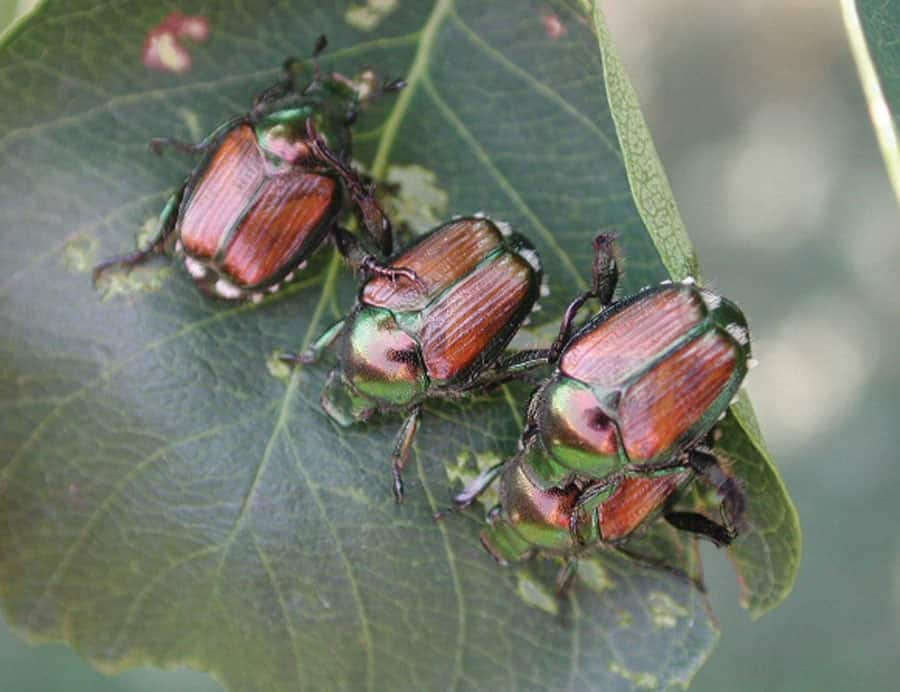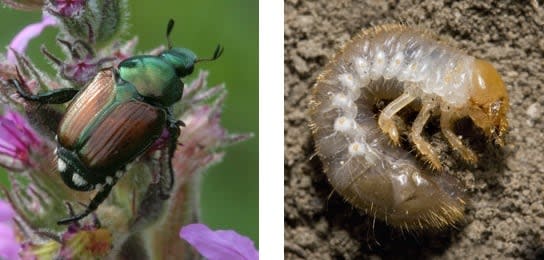How gardeners can get an early start on their battle with the Japanese beetle

It's almost the time of year when gardeners on P.E.I. unlock their sheds and dig out their rakes, trowels and gloves.
It's also time when they start planning how to combat their arch nemesis — the Japanese beetle.
The invasive insect has been on P.E.I. since 2009, but last summer they seemed particularly populous, chewing threw lush green leaves and leaving them brown and full of holes.
While they have been mostly contained to the Charlottetown area, they have been spotted in Kings Castle Provincial Park, Nine Mile Creek and Rocky Point in recent years.
Clay Cutting, a technician with the P.E.I. Invasive Species Council, says getting to the pests early is better than waiting until they're full-fledged flying adults.
"They love to breed in nice lawns, nice lush lawns and so on Prince Edward Island, we don't have any shortage of those," he said in an interview with Island Morning.

Adult Japanese beetles are around 10 millimetres long, metallic green and have bronze-coloured wings. Their larvae are C-shaped, white and have a yellowish-brown head. (David Cappaert/Bugwood.org/Province of British Columbia)
Cutting suggests pulling up a piece of the lawn, especially if it has brown patches, to check for Japanese beetles.
"If you look around the edges of that brown patch, there will probably be some white grubs. So you can actually pick out one of these grubs," Cutting says.
He notes that they can be distinguished from June bugs, which are native to P.E.I., by the V-shaped hair pattern on their behinds.
"They're a little gross and they're a little grabby and they have these little legs that kind of try to grab onto you. So do avoid that. But there are little hairs on their butt, on the raster as it's called. And the pattern of the hair is actually what I would use to identify those Japanese beetles."
Apply nematodes early
If you find them, applying beneficial nematodes to the area is a good way to eradicate them, Cutting said.
"If you attack them when they're grubs, they're not going to grow up to be adults. And so the effects on your plants will reduce."
It gets more difficult once they are adults. The adult season on P.E.I., when they do the most damage, is generally from about mid-July until mid-October.
Many gardeners suggest flicking them into a jar of hot, soapy water. Or if you're dealing with row plants in a garden, you can put a floating row cover, which looks like light netting, over the plants.
Simply squishing a Japanese beetle could release pheromones that will attract more of them.
However, pheromone traps could work if they are placed away from the garden, such as near a telephone pole by a curb.
Get neighbours on board
It's also a good idea to collaborate with neighbours, Cutting said.
"This can be much more effective to control at a landscape scale rather than you simply managing on your own property. It is good to get the whole community on board if possible."
So is the Japanese beetle expected to be as big a problem this year than last?
Paul Manning, an assistant professor of agriculture at Dalhousie University, said a lot depends on how larvae living in the soil were able to withstand different diseases like funguses and bacteria that are "more than happy to invade them and kill them."
"So if you have a really, really moist spring with lots of rainfall and damp soil, then that can really push up the number that are killed by bacterial or fungal pathogens."

 Yahoo News
Yahoo News 
